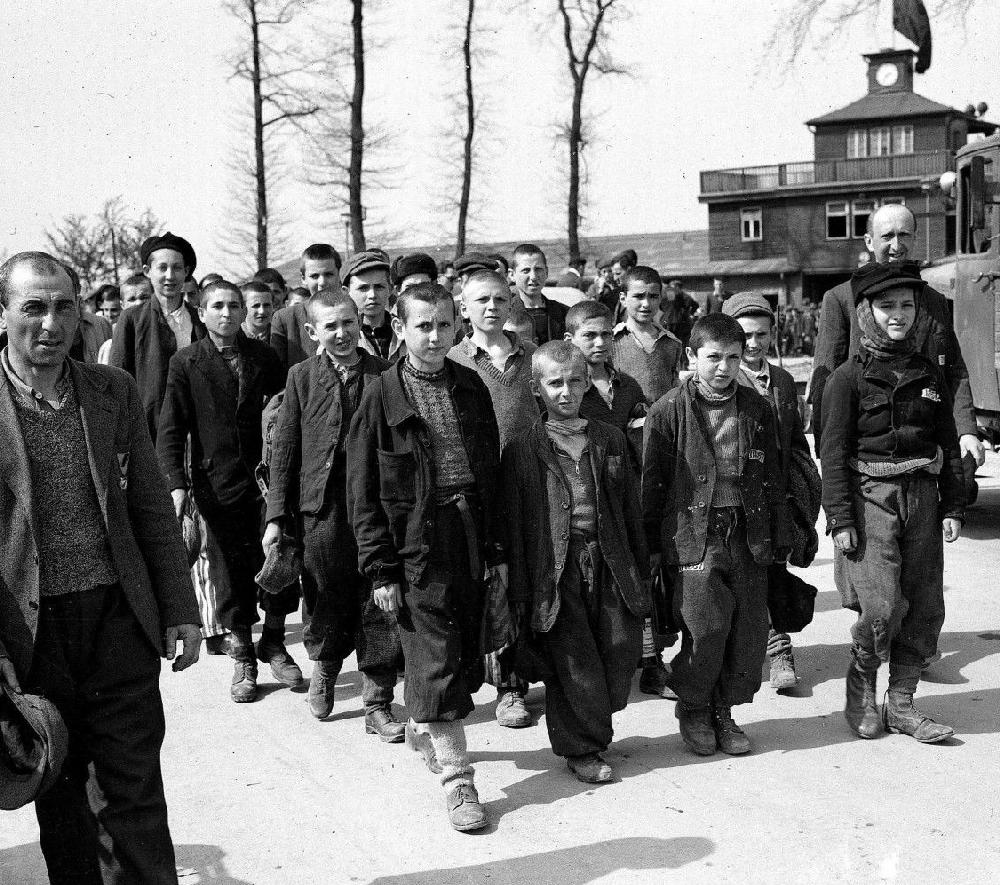
NAZI Concentration Camps: Buchenwald --Liberation (April 11, 1945)

Figure 1.--The American reached the Buchenwald main camp (April 11, 1945). They found over 20,000 starving inmates. The SS had forced some 40,000 prisoners out of the Camp at gun point. The children and youth were aming the survivors. They had been lined up by the SS as part of the death marches, but were sent back to their baracks when Allied uircraft overflew the Camp (April 10). The next day the Americans arrived. Here a few days after lineration the boys are being taken to a nearby American military hospital for medical care. The tall boy in the rear is Elie Wiesel.
|
|
The liberation of German concentration camps was more complicated than actually depicted. The major camps had multiple sub-camps, some of which were sizeable. The process began an Ohrdruf, a Buchenwald sub-camp (April 4). Units of the U.S. 89th Infantry Division entered the camp. It was the first camp liberated by the Americans pushing into the Reich. U.S. soldiers at heard of NAZI concentration camps, but none including the top commanders were prepared for what they found. The SS after the Americans reached Ohrdurf began 'evacuating' the main Camp. While the evacuationds were in process, Polish engineer and pre-War short-wave radio-amateur, Gwidon Damazyn, who had been an inmate at Buchenwald since March 1941, cobbeled together a short-wave transmitter and generator in the camp movie room. Damazyn and Russian prisoner Konstantin Ivanovich Leonov sent a Morse code message approved by the prisoners' underground resistance. (April 8). It read: "To the Allies. To the army of General Patton. This is the Buchenwald concentration camp. SOS. We request help. They want to evacuate us. The SS wants to destroy us." The transmission was sent several times in English, German, and Russian. Three minutes after the last transmission, the headquarters of the U.S. Third Army responded: "KZ Bu. Hold out. Rushing to your aid. Staff of Third Army." After receiving the reply from the Americans, Communist inmates stormed the watchtowers using arms they had been collecting since 1942 (one machine gun and 91 rifles) and killed the remaining SS guards. A small detachment of troops of the U.S. 9th Armored Infantry Battalion (6th Armored Division, U.S. Third Army) commanded by Captain Frederic Keffer, reached the mnaingate (April 11). It was 3:15 pm which is imortalized by the settinhg of the clock at the entrance gate. The soldiers were given an emotional hero's welcome. Shortly after a larger firce of the U.S. 83rd Infantry Division overran Langenstein, another sub camp. The soldiers there found 21,000 prisoners. Thecommander ordered the mayor of Langenstein to immediately send food and water to the camp. He requested medical supplies to be rushed from the 20th Field Hospital. Third Army Headquarters ordered sent elements of the 80th Infantry Division to take control of the camp and what they could for the starving inmates (April 12). Journalists arrived on the same day. The reports nd phoytograohs, shiockd America to the core. There were many reoports about the NAZI camps, but very few Americans imagined the extent of NAZI depravity. Among the journalists was Edward R. Murrow. His broadcast describing liberation of the camp was broadcast on CBS radio in the States. This briadcasts along with his briadcasts from London during the Blitz are major audio documnts of the War. He intioned in that famous voice, :"I asked to see one of the barracks. It happened to be occupied by Czechoslovaks. When I entered, men crowded around, tried to lift me to their shoulders. They were too weak. Many of them could not get out of bed. I was told that this building had once stabled 80 horses. There were 1,200 men in it, five to a bunk. The stink was beyond all description. They called the doctor. We inspected his records. There were only names in the little black book, nothing more. Nothing about who these men were, what they had done, or hoped. Behind the names of those who had died, there was a cross. I counted them. They totaled 242. 242 out of 1,200, in one month. As we walked out into the courtyard, a man fell dead. Two others, they must have been over 60, were crawling toward the latrine. I saw it, but will not describe it." [Murrow] As bad as this sounded, Buchenald was so crowed that many did not even have barracks to live in. Conditions were so terrible in the Camp that even after liberation and the arrival of food and medicine, some 40 inmates were dying daily.
Sources
Murrow, Edward R. 'Buchenwald Report' (April 15, 1945).
CIH -- WW II Holocaust

Navigate the CIH World War II Holocaust Section:
[Return to Main Buchenwald page]
[Return to Main individual concentration alphabetical A-L camp page]
[Return to Main individual concentration camp page]
[Return to Main concentration camp page]
[About Us]
[Allies]
[Biographies]
[Children]
[Concentration camps]
[Countries]
[Decision]
[Denyers/Apologists]
[Displaced persons]
[Economics]
[Eisatzgruppen]
[Eugenics]
[German Jews]
[Ghettoes]
[Impact]
[Justice]
[Literature]
[Movies]
[NAZIs]
[Occupied Poland]
[Process]
[Propagada]
[Resistance]
[Restitution]
[Questions]
[SA]
[SS]
[Special situations]
[Targets]
[Wansee Conference]
[Return to the Main World War II]
[Return to Main Holocaust page]
[Return to the Main mass killing page]
[Return to CIH Home page]
Created: 11:33 AM 5/15/2018
Last updated: 11:18 AM 5/15/2018



